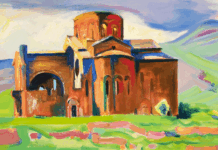LA CAÑADA, Calif. – In Armenian circles, many know Armen Edgarian as a graphic designer. He has done freelance designing for various departments of the Eastern Diocese of the Armenian Church of America and St. Nersess Armenian Seminary in New York for several decades, and has prepared the ads and mailings for the new Tekeyan Cultural Association (TCA) Metro Los Angeles chapter. His full-time job is a Financial Publishing Specialist, meaning that he does graphic design production work for a financial company, and he has worked for prestigious firms like the Wall Street Journal Custom Studios and Hearst Magazines. But his heart is in his personal art, and his first solo exhibition of mixed media photographs, called Urban Transitions, opens Saturday, October 5 at Stephanie’s Gallery in La Cañada, California. The TCA Metro Los Angeles chapter is supporting this event.

Born in Iran, Edgarian lived in Spain for two years, and came to the US when 22 years old. While he was in Spain, he met an Iranian photojournalist by the name of Bruce Shahidi, who introduced Edgarian to photography by showing him photographs he took in Iran and in places all around the world. Edgarian said that he still has the first photograph Shahidi showed him.
Edgarian majored in photography and computer graphics at the Pratt Institute in Brooklyn, New York, and graduated in 1996. Though he took painting classes, he decided to focus on photography and design, and his photographs in New York were of a more traditional variety. He had participated in two or three group shows. Edgarian exclaimed that “This [present] show is major and life-changing for me! I found my medium and I am going to continue doing it. Hopefully, it will excite people as well who look at this art and see something different.”

Edgarian explained further: “The reason I am having this show is that I moved to Los Angeles. Almost every subject that I have in the show is from Los Angeles. The Los Angeles area is not like New York. It is just suburban houses, with no subjects for me to photograph. So I ended up going around all the new construction sites that are happening in downtown Los Angeles. Most of the subjects are from those boarded up wooden boards around new construction sites where people come and put up posters, and somebody comes and puts up a poster on top of that. Then the building management paints over it or rips it up. This creates subjects for me, and every day I go and try to see what changes and I take pictures.”

In this downtown area, Edgarian said, all the advertising for music groups, theaters and events are posted on these walls, and people put graffiti or other posters on it. This becomes his canvas.
Edgarian likes to call what he does now photopainting. He said, “The thing with the posters and the paint, people come and do graffiti. It is just the combination of everything that creates something new. I get really close. I really zoom in to a section of a wall and then photograph that. What happens is that I am getting closer and closer and closer to my subject. Before, I used to take a photograph, let’s say, of a door in the Village or in New York.…Now I get closer and take a picture of the lock that is on the door. This is the comparison. I get closer to those papers, the colorful textures on the wall, the wooden board itself, the paint that the management puts over it so it wouldn’t be an eyesore for the public. Just a combination of everything, it has become this array of colorful and yet beautiful compositions that you pass by and don’t notice. Then you look closely, and you see that there is so much going on.”









